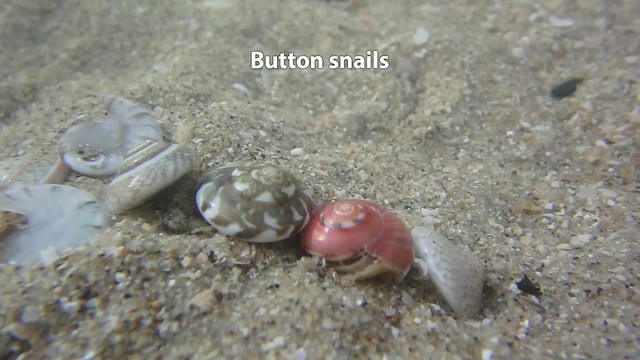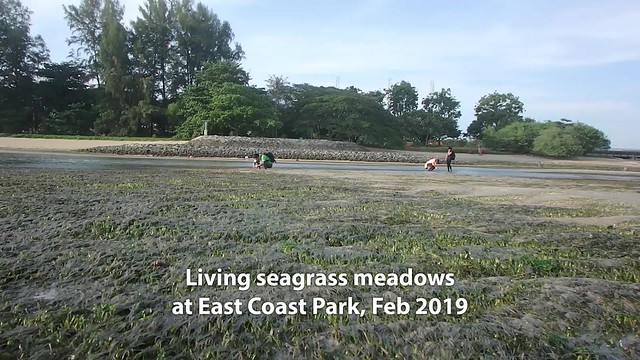There are living sandy shores, seagrass meadows and even patches of coral reefs! But beware of the Stonefish.
On the shore directly opposite NSRCC, there is a huge sand bar full of life.
The sandbar is teeming with burrowing life. Lots of pretty Button snails lie buried just beneath the sand. These are hunted by predatory Ball moon snails and Weasel olive snails. Here's a video of Button snails, the predators that eat them, and what happens after they die. There are also lots of Cake sand dollars.
At the mouth of the canal nearby, lush seagrasses have settled naturally, without any human planting! These are home to common animals like Orange-striped hermit crabs, and Haddon's carpet anemones.
Seagrasses and living sandy shores also thrive on the shore opposite the National Sailing Centre (Carpark G). A long and wide sand bar next to the canal mouth forms a calm shallow lagoon for seagrasses and other marine life to thrive.
Among the amazing marine life seen here lots of sea cucumbers of various kinds. And sea stars and sea urchins too. In the sand bar, there were lots of sand dollars, and pretty Button snails who were hunted by the usual predatory moon snails and olive snails
Another lush seagrass meadow has settled naturally at the mouth of the canal off the Coastal Park Connector at Tanah Merah Coast Road. WARNING: It is only safe to cross the canal at the lowest tide. At other times, the current is very strong, so do NOT attempt to cross. Access to this shore is via Changi Coast Walk, entrance next to MOE Changi Coast Adventure Centre - walk towards Tanah Merah Ferry Terminal.

This naturally settled reef has the usual common reef life like Giant carpet anemones. I even saw several Clown anemonefishes in one of them!
A less welcomed encounter is the stonefish, which are commonly encountered on all our East Coast shores. Especially near seawalls and reefy areas. These fishes are almost impossible to spot. If you step on the fish, its tough spines will penetrate even through thick soled booties. These act like hypodermic needles, injecting a venom that can be fatal to humans. The stonefish neurotoxin is considered the most deadly of the fish venoms. The victim should be brought to hospital as soon as possible. So do take note and work out an evacuation route from your destination to the nearest pick up by an ambulance.
How to stay safe: Wear covered shoes. Watch your step and walk slowly. If you feel a prick through your shoe, pull back and don't step down with your full body weight. Do not step into murky water.
Guided intertidal walks at East Coast Park
Ideally, it's best to visit a shore with an experienced and trained guide. Why?
See more! Experienced guides are familiar with the terrain and seasons of the shores. They can show you more during the short window of low tide. They can also tell you more about what you see so you can learn more.
Minimise your impact: Every inch of the shores are alive with small animals and growing plants. An experienced guide will help you see more and yet minimise the impact of your visit.
Have a great time! Guides are eager to ensure you have an enjoyable visit. Whether you are just there to see what's so special about the shores, or if you need more details for a project or have a special area of interest. Do tell your guide, who will gladly try to help you.
Consider joining walks by Young Nautilus who have pre-planned visits and will also gladly organise trips to fit your schedule. More about their public programmes.
When is the best time to visit our shores?
Singapore waters tend to be murky and cloudy (like 'kopi susu') because of the high sedimentation. Thus, if you go at high tide, you can't see much. However, just because you can't see something, doesn't mean there is nothing there.
The rich shorelife is more easily seen at low tide. The lower the tide, the larger the expanse of shore exposed and a wider variety of shorelife can be seen.
It's best to visit with the outgoing tide. The water is clearer as the tide falls, and in areas where a calm shallow lagoon forms at low tide, behind a sand bar. The water tends to get murky as the tide turns and water rises and rushes in.
Singapore has two low tides and two high tides a day. The height of the tide is not the same every day. High and low tides do not happen at the same time every day, and the highest and lowest tide level change every day. Tides suitable for a visit to the shore do not necessarily occur on a weekend. Suitable tides usually fall before sunrise and after sunset. There are few suitable tides during daylight hours.
Here's more about the tides: what causes them, and about Singapore's tides.
How low should the tide be to see something at East Coast Park?
The ideal tide for intertidal exploration is 0.1m or lower for Changi tide tables. Such low spring tides tend to occur near or after sunset at this time of the year. So be prepared with a small torch.
The marinas based at Changi provide on their website, the hour-by-hour predicted tides for Changi. Links to these and more about Singapore's tides here.
Safety on the shore!
Comply with all prevailing COVID regulations. Visit the NParks SafeDistance website to check on the current crowding at the location, and for the latest COVID regulations.
Lighting and rain: Immediately evacuate to one of the park shelters at the first signs of the weather turning bad. Lightning can occur without rain. Get the latest weather situation here: radar readings updated every 10 mins.
Don't touch! All animals defend themselves from predators or they will be eaten up and soon become extinct. Some of these animal defences can cause humans irritation, pain or even worse injuries and death. As with any nature walk, it is important to respect the wildlife: do not touch animals, don't poke them, leave them alone. Cover all skin that can be exposed to the water; wear covered shoes. Do not walk on bare feet. Closely supervise young children who may accidentally touch animals, then rub their eyes or put fingers into the mouth.
At the same time, our visit also affects the safety of the shores. Our shores are fragile. Many small sea creatures live in the sand and mud. These are killed when we step on them, no matter how gently we walk. These small sea creatures form the base of the entire food chain on our shores. Seagrass have delicate roots and take a long time to recover when trampled on.
If we are not careful, we can damage the shore when we visit. Be gentle. Watch your step. Avoid wading into deeper murky waters as you won't be able to see what you are stepping on. Don't poke animals or dig them up or bring them home. Take only photos.
MORE tips for safety on our shores and FAQs about shore visits.
What is the future of East Coast shores?
These living East Coast shores are precious because they may be reclaimed in the 2013 landuse plan by the Ministry of National Development released in response to 2013 Population White Paper.
The blue outlined areas are "Possible Future Reclamation". The plans include massive reclamation along the entire East Coast.
Natural regeneration on Singapore's artificial shores and structures is already happening now. Unintentionally, with zero replanting. Can we plan coastal works to allow reefs, mangroves and seagrasses to naturally regenerate? Naturalise canals leading to the sea for a continuum of freshwater wetlands to mangroves? Imagine what's possible! Reefs and natural marine ecosystems at our doorstep, for all in the City to enjoy. More about this idea in my feedback to the Draft Master Plan 2013.
Links to more
Latest about East Coast Park on the NParks website.
More about what I've seen at all the East Coast Park shores in surveys done for more than ten years.













